Sôjiji's stamp, seal and crest
Historical
Overview
A dozen
or so magnificent structures in the spacious temple grounds may make the laity
believe that the Temple was founded centuries ago. It certainly has a long historical
background. However, the original temple was not constructed here but in the
Noto Peninsula, Ishikawa Prefecture. It was a Shingon Sect temple named Moro-oka-dera
and founded circa 740 by Priest Gyoki (668-749), a great Buddhist who erected
the world-famous Todaiji in Nara and many others including Sugimoto-dera in
Kamakura. In 1321, Priest Jokin Keizan (1268-1325), the founder of the Temple,
was invited to be the chief priest of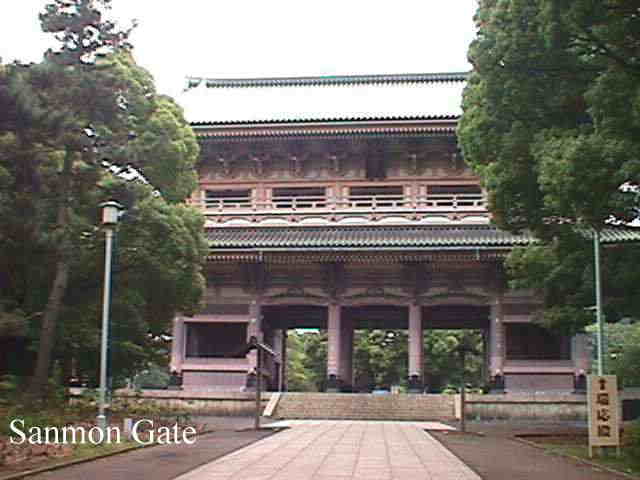 Moro-oka-dera. Shortly after assuming the post, Priest Keizan
changed the devaluation from the Shingon to the Soto Zen sect with the approval
of Emperor Godaigo (1288-1339), and renamed it Sojiji. It flourished under the
patronage of fourth consecutive emperor. During the Muromachi Period (1336-1573)
through the Edo Period (1603-1868) , the Shogunate gave support to the Temple
and appointed it their prayer hall. At one time of its peak, the Temple had
as many as 70-odd structures in its temple grounds in Noto. The Temple and Eiheiji
in Fukui Prefecture which was established in 1244 by Priest Dogen (1200-1253),
the founder of Soto Zen, have been the matchless twin of the Sect in Japan.
Moro-oka-dera. Shortly after assuming the post, Priest Keizan
changed the devaluation from the Shingon to the Soto Zen sect with the approval
of Emperor Godaigo (1288-1339), and renamed it Sojiji. It flourished under the
patronage of fourth consecutive emperor. During the Muromachi Period (1336-1573)
through the Edo Period (1603-1868) , the Shogunate gave support to the Temple
and appointed it their prayer hall. At one time of its peak, the Temple had
as many as 70-odd structures in its temple grounds in Noto. The Temple and Eiheiji
in Fukui Prefecture which was established in 1244 by Priest Dogen (1200-1253),
the founder of Soto Zen, have been the matchless twin of the Sect in Japan.
Unfortunately, however, Sojiji in Noto was almost totally destroyed by fire
in 1898. In reconstruction talks, leaders of the Temple insisted that it should
be relocated somewhere near Tokyo to spread the Soto Zen in eastern Japan. With
another great Soto Zen temple Eiheiji located only 150 kilometers south, it
made sense to move it near nation's capital, though there was a serious controversy
over the relocation. Finally, they reached a conclusion to relocate. Thirteen
years later in 1911, the new Sojiji officially started its religious services
at the present site in Tsurumi, Yokohama. The Temple has, therefore, a history
of less than a century.
Priest Dogen: Founder of the Soto Zen
Before
referring to the Temple structures, I feel it necessary to tell you about Priest
Dogen, one of the greatest Buddhists in Japan. He was born into a noble family
in Kyoto but lost his father at age 3 and mother at age 8. An orphan, he entered
Enryakuji at Mt. Hiei, Shiga Prefecture at age 13 and took Buddhist vows the
next year. Later, he joined Ken'ninji, the mother temple of Ken'ninji school
of the Rinzai Zen and founded by Priest Eisai (1141-1215), the founder of the
Rinzai Zen, where he studied Zen for six years. In 1223, he went to Zhejiang,
China and became a student of the Soto Zen master Zhangweng Rujing (1163-1228),
the chief priest of the temple on Mt. Tiang-tong. Priest Dogen was so excellent
and capable that in 1227 Priest Rujing named him as the successor in the tradition
of the Soto Zen (T'sao-tung in Chinese).
Upon his return to Japan the same year, he introduced the Soto Zen into Japan
and tried to spread the teachings. Predictable as it may have seemed, he faced
the animosity of the priests at Enryakuji, then the most powerful stronghold
for the Japanese Buddhism based on the Tendai tenet. He had to move from one
temple to another bearing hardship. During those years from 1231 through 1253,
however, he wrote the famous Shobo Genzo, which is translated as "Treasury
of the True Dharma Eye" or "The Eye Treasury of the True Dharma", a Zen philosophy
discourse made of 95 volumes. (He died before he achieved the target of 100
volumes. It is too difficult to understand for today's ordinary Japanese including
me.) The book is a collection of his Buddhist sermons and honored as the basic
scripture by the Soto Sect Buddhists. What he says is, in essence, that Zazen
or sit-in meditation is most important for the Buddhists and one should know
oneself like the Greek philosopher Socrates' words "Know thyself". Zazen is
not the measures to obtain enlightenme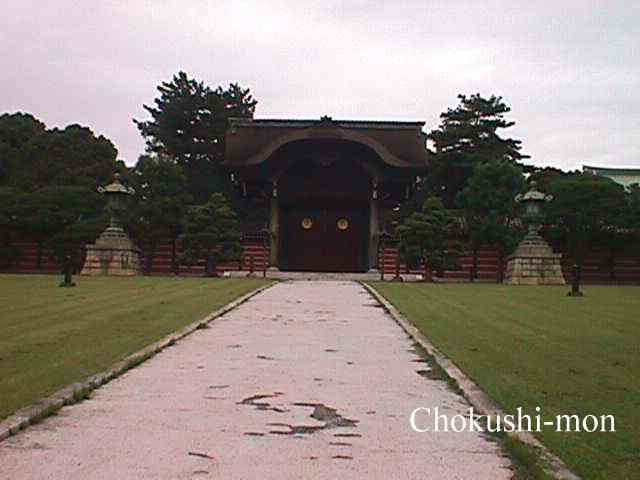 nt but practicing Zazen is the enlightenment
itself. His view further provoked hostility of Enryakuji and he was ousted from
Kyoto. An excommunication in Buddhist way. Nowhere to stay in Kyoto, he went
to Fukui Prefecture and built a temple named Daibutsuji in 1244, which was renamed
Eiheiji two years later.
nt but practicing Zazen is the enlightenment
itself. His view further provoked hostility of Enryakuji and he was ousted from
Kyoto. An excommunication in Buddhist way. Nowhere to stay in Kyoto, he went
to Fukui Prefecture and built a temple named Daibutsuji in 1244, which was renamed
Eiheiji two years later.
Back then in Kamakura, Tokiyori Hojo (1227-1263) was the de facto ruler of Japan
as the Fifth Hojo Regent. He was greatly interested in Zen and was about to
found Kenchoji. Tokiyori invited Priest Dogen to Kamakura in 1247 and told him
that Tokiyori would erect a temple for him if he accepted to become the founding
priest. He stayed in Kamakura for six months and performed religious services
teaching the Soto Zen, but turned down Tokiyori's offer. To associate with the
man of authority was the last thing he wanted. This is the main reason the Soto
Zen took hold in the rural areas while the Rinzai Zen flourished in towns like
Kamakura and Kyoto.
Priest Keizan: Founder of the Temple
After
Priest Dogen passed away in 1253, the chief's post of the Soto Zen was succeeded
to Priest Ejo Ko-un (1198-1280), and then to Priest Gikai Tettsu (1219-1309).
The fourth successor was Priest Keizan, the founder of the Temple.
http://www.zen-occidental.net/divers/keizan.html
Born in Fukui Prefecture,
he took the tonsure at age 8 to become a shami (sramanera in Skt.) or
a Buddhist acolyte and entered Eiheiji to study Buddhism under the guidance
of Priest Tettsu, the third chief priest of Eiheiji, who was then at Enryakuji.
As early as at age 13, Priest Keizan was ordained by Priest Ejo, and several
years later, his master gave him the title of Ino (Karmadana in Skt.),
in other words, a license to teach Buddhism to the training priests. Thereafter,
he was welcomed as a chief priest in various temples, mostly in western Japan,
and at the age of 31, the number of priests he had ordained counted more than
70. Most notable in his mission was that he enrolled quite a few women in his
class and taught them Buddhism. Back at the time, society was by and large male-dominated,
and more so in Buddhist circles. Priest Keizan may have been one of the the
few equal right advocates in medieval Japan.
He was excellent in preaching and greatly contributed to the spread of the Soto
Zen combining it with elements of the esoteric Buddhism to some extent such
as incantation and requiem masses. While Priest Dogen studied the Buddha teachings
in self-cultivation, Priest Keizan showed them outward.
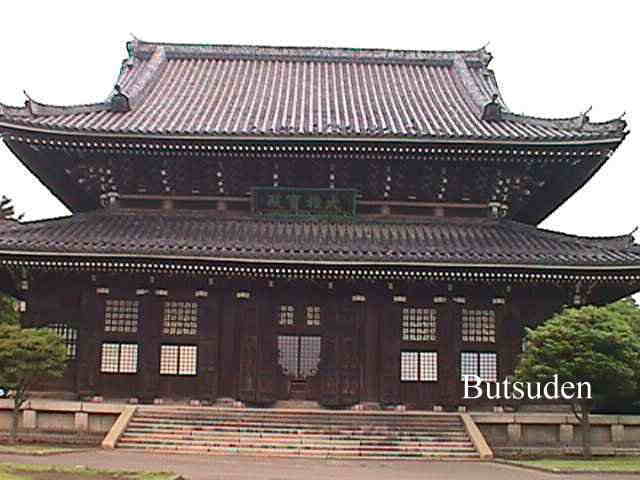 In 1321, he was granted Moro-oka-dera
in the Noto Peninsula in response to his great contributions, which he later
changed the cult to the Soto Zen and renamed as Sojiji, the origin of today's
Temple, as noted earlier.
In 1321, he was granted Moro-oka-dera
in the Noto Peninsula in response to his great contributions, which he later
changed the cult to the Soto Zen and renamed as Sojiji, the origin of today's
Temple, as noted earlier.
To pay respect to Priest Dogen and Priest Keizan, the Soto Sect conferred the
honorific titles on them. Namely, Priest Dogen is called Koso or the
Great Patriarch, Priest Keizan is named Taiso or the Initial Patriarch,
and the two are addressed as Ryoso or the Duo Patriarch.
The Temple has a complete set of seven structures called Shichido Garan
in Japanese in its grounds, though not symmetrically designed as Typical Zen
temples. Together with Eiheiji in Fukui Prefecture, it is the headquarters of
the Soto Sect and has, according to its homepage, 15,000 sub-temples and 8 million
followers throughout the world.
Sanmon or Inner Gate
This
copper-roofed magnificent gate was constructed in 1969 getting donations from
Toyojiro Kihara (1890-1974), a large forest owner and follower of the Soto Sect.
He believed his success in business owed greatly to his wife Yoshi. When his
beloved wife died of sickness in 1966, he entered priesthood naming himself
So-un and buried her ashes in the Temple's graveyard. The gate was constructed
to the memory of Mrs. Kihara and as a token of his gratitude to her. It is among
the largest of its kind in Japan. Although Kihara was called the Forest King
of Japan and a major supplier of pulpwood before World War II, the gate is not
made of wood but is a reinforced concrete building. (Note. Japan is the second
largest paper producer in the world next to America. Before the War, paper was
made 100 percent from woodfiber. Today' paper is, however, 60 percent recycled
content on an average.) It measure 9 by 23 meters and 22 meters high. Installed
to the both sides of the gate are a pair of statues of Kongo-Rikishi or Vajra
Pani in Skt.: One on the left is named Misshaku (Guhya-pada in Skt.) and the
other on the right is Nara-en (Narayana in Skt.). On the upper floor, statues
of Jizo Bosatsu (Ksitigarbha in Skt.) and Sho Kan'non (Arya-avalokitesvara in
Skt.) are enthroned, surrounded by 16 rakan (Arhat in Skt.) or Sakyamuni's 16
immediate disciples. The Jizo Bosatsu statue was fashioned by Seiki Abe (1912-1978),
a member of the judge panel for the Japan Fine Arts Exhibition. (Abe
is, meanwhile, a popular family name in Japan, but pronounced ah-beh, not like
the nickname of Abraham.)
Chokushi-mon Gate
Chokushi
denotes an imperial order, and therefore, the gate was used on the occasion
of the imperial mission visiting the Temple. A pair of yellow chrysanthemum
crests appearing on the doors indicate they are the imperial family's emblem.
The Temple was closely associated with the family in early days. Emperor Godaigo,
for example, studied Buddhism with the Priest Keizan. The gate was build in
1925, while Emperor Taisho (1879-1926) was in supremacy.
The corridor stretches to the east and the west connecting the buildings of
both sides. Its is called 100-ken corridor (ken is an old unit of length
or 1.8 meters), and are designed to practice Zazen inside the corridor.
Butsuden or Main Hall
Butsuden
is a Zen Sect's term for the main hall, and in case of the Temple, it is called
Dai-o-hoden. Construction started in 1907 and completed eight years later
in 1915. The stately 21.8 meter-square building, made totally of zelkova trees,
has double and semi-gabled roofs.
Enshrined on the center altar of the hall is a statue of Shaka Nyorai or Sakyamuni
in Skt., the main object of worship, flanked by Kasho (Kasyapa in Skt.) on its
left and Anan (Ananda in Skt.) on its right. The duo are among the ten greatest
disciples of Shaka. The term Dai-o-hoden denotes the halls that house
these trio statues. In the left recess are sedentary statues of Bodhidharma,
the patriarch of the Chinese Zen in the 6th century, and of Priest Ryokai Dosan
(807-869), (Dong-shan linang-jie in Chinese), the patriarch of Chinese Soto
Zen. Installed in the right recess are sedentary statues of Priest Rujing and
Daigen Shuri Bosatsu, that is a guardian deity of religion and is always enshrined
in the main hall.
Daisodo or Founders'
Hall
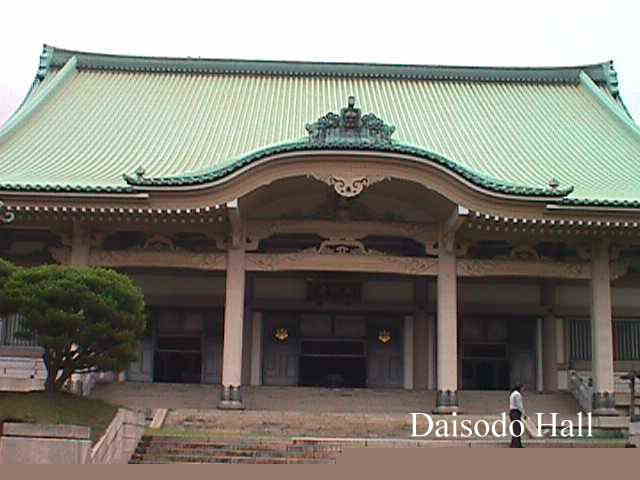 Even
more stately than the main hall is this building standing right-hand side of
the main hall. Daisodo is literally the great founders' hall. Here at
the Temple, it functions not only as the founders' hall but also as the lecture
hall. In other words, it is also a hatto in Zen term.
Even
more stately than the main hall is this building standing right-hand side of
the main hall. Daisodo is literally the great founders' hall. Here at
the Temple, it functions not only as the founders' hall but also as the lecture
hall. In other words, it is also a hatto in Zen term.
The copper roofed gorgeous building of reinforced concrete, 54.5 by 47.2 meters
and 39 meters high, was built in 1965 in commemoration of the 600th anniversary
of death (onki in Japanese) of the Second Chief Priest Shoseki Gazan
(1275-1365). He is famous for his longevity and during his term of office as
the chief priest, he produced a number of great priests. Onki is a memorial
service held every fifty years for the founding priests or the great priests.
Construction cost the Temple 1,500 million yen, all funded by the Soto Zen followers
including those in Hawaii.
Inside the hall, the floor is as spacious as 40-meter square and is covered
with 1,000 tatami mats. Enthroned on the altar are statues of Priest
Keizan in the center, Priest Dogen to its left and Priest Gazan to its right.
Besides them, five more statues are installed in the left and right recesses.
All of them are the founding priests of the major Soto Zen temples. Every morning
and evening, roughly 100 priests hold religious services in this hall.
Daisodo is large enough for the chief priest to deliver a sermon to the
training priests or disciples. Placed in the inner center is a platform called
Shumi-dan. Usually, Shumi-dan is a pedestal on which the Buddha
statues are installed. (The term Shumi originates in the Mt. Sumeru of
the Buddhist universe). Here in Daisodo, however, it is a platform on
which the chief priest stands to make lectures. No other priests are permitted
to step on it.
Daisodo or Hatto
In alphabet,
it is spelled the same as the Founder's Hall above, but slightly different in
kanji characters and pronunciation. It serves as a Senbutsujo,
a hall in which screening of priests who attained Nirvana are conducted (a Zen
sect version of ordainment) and is one of the most important structures for
Zen temples. Usually built to the west of the main hall, it is dedicated to
a statue of Monju Bosatsu or Manjusri Bodhisattva in Skt. , which is the Bodhisattva
of wisdom and intellect. Today's Daisodo here is the main training center
for Zen priests.
In this hall, they sleep, eat, study and practice Zazen. Each is given a space
of only one tatami mat (1.8 by 0.9 meters). There are three places Zen
priests have to keep absolutely silent: Dining rooms, bathrooms and restrooms.
While eating, bathing or excreting, they are not allowed to make any noise.
These acts are thought to provide them with good opportunities to train themselves.
The hall, therefore, must always be quiet, so quiet as you might hear a pin
drop. They also study Buddhism in this hall right in front of Monju Bosatsu,
the Bodhisattva of wisdom and intellect
The building was designed by Chuta Ito (1867-1954), an authority on Japanese
architectural history and professor of Tokyo University, who unearthed the stone
Buddhist images at Yungang, China for the first time and introduced them to
the world. He is also known as an expert on the architecture of Horyuji in Nara.
Included among the famous buildings he designed are Meiji Jingu Shrine, Tsukiji
Honganji, both in Tokyo, and Heian Jingu Shrine in Kyoto. In 1943, he was awarded
an Order of Cultural Merit, first ever from the architectural field. The copper-
and semi-gable roofed building of the Temple took seven years to be completed
in 1933.
Koshakudai
Too luxurious
though the building may seem, it is a Kuri or priests' living quarters
constructed in 1920. The term Koshaku is a translation of Sanskrit "Gandha-sugandhaIn"
meaning fragrance. It is said that at the time the remains of Sakyamuni was
cremated, fragrant trees were burnt. Zen temples often use the term Koshaku
as living quarters. In the center recess, a wooden statue of Daikokuten,
or Mahakala in Skt., the largest of its kind, is enshrined. (Kuri in
Zen temples usually enshrines a statue of Idaten or Skanda in Skt.).
Daikokuten is one of Shichifukujin or Seven Deities of Good Fortune
and it is the God of Wealth and the God of Five Cereals. The statue usually
wears a hood and holds a big bag filled with treasures on his left shoulder.
In his right hand, he holds a luck mallet, often astride two straw-wrapped rice
bales.
Hokodo Hall
The building,
20 by 29 meters, made of Japanese cypress with semi-gabled roof was relocated
here from the Noto Peninsula in 1911 and is sacred to the memory of parishioners'
ancestors. Enthroned on the altar is a statue of Hoko Bosatsu or Jvalana
in Skt. On the altars, a number of mortuary tablets for the past parishioners
are installed. Memorial services for those are held regularly in this hall.
Hoko denotes the emission of light. Until Daisodo was completed,
the Hall had served as Hatto.
Goreiden
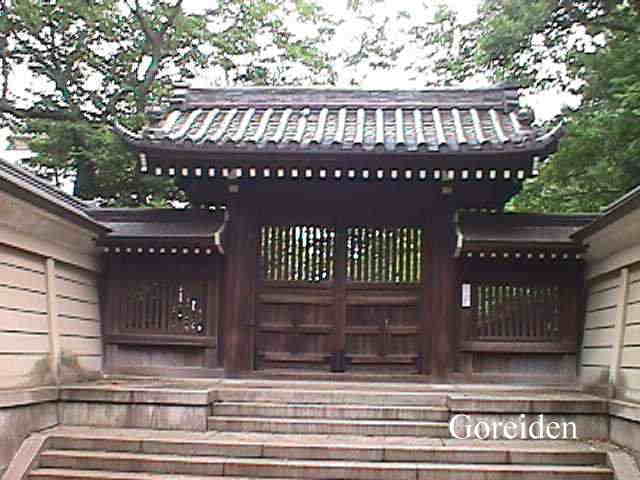 Behind
the Main Hall and to the left of the Daisodo Hall is a 992-square-meter
enclosure, which is for Emperor Godaigo and the shrine-like building called
Goreiden (go is an honorific prefix) is dedicated to his soul.
The building with semi-gabled and cypress-shingled roofs was built in 1937 in
commemoration of his 600th anniversary of death. Emperor Godaigo gave the Temple
a large panel inscribed with the name of Sojiji, a symbol of imperial patronage.
At one time, he learned the Soto Zen a lot from Priest Keizan, the founder of
the Temple. The following four emperors, i.e. Emperors Gomurakami (1328-1368),
Gonara (1496-1557), Goyozei (1571-1617) and Gokomyo (1633-1654) also patronized
the Temple and the Goreiden enshrines their memorial tablets. (Note.
The prefix go of each emperor's name here is not an honorific prefix,
but simply denotes "post" or "next". In case of Emperor Gomurakami, for example,
there was Emperor Murakami before.) Today's emperor is, however, unable to support
any specific religions or temples because of the Constitution which guarantees
the freedom of religion and prohibits the imperial family from getting involved
in other religions than its own Shinto.
Behind
the Main Hall and to the left of the Daisodo Hall is a 992-square-meter
enclosure, which is for Emperor Godaigo and the shrine-like building called
Goreiden (go is an honorific prefix) is dedicated to his soul.
The building with semi-gabled and cypress-shingled roofs was built in 1937 in
commemoration of his 600th anniversary of death. Emperor Godaigo gave the Temple
a large panel inscribed with the name of Sojiji, a symbol of imperial patronage.
At one time, he learned the Soto Zen a lot from Priest Keizan, the founder of
the Temple. The following four emperors, i.e. Emperors Gomurakami (1328-1368),
Gonara (1496-1557), Goyozei (1571-1617) and Gokomyo (1633-1654) also patronized
the Temple and the Goreiden enshrines their memorial tablets. (Note.
The prefix go of each emperor's name here is not an honorific prefix,
but simply denotes "post" or "next". In case of Emperor Gomurakami, for example,
there was Emperor Murakami before.) Today's emperor is, however, unable to support
any specific religions or temples because of the Constitution which guarantees
the freedom of religion and prohibits the imperial family from getting involved
in other religions than its own Shinto.
Shi-untai
The 30
by 34 meters building made of Japanese cypress was constructed in 1915 as a
drawing room where the chief priest of the Temple always meet with VIPs. Making
this hall famous are the pictures painted on the Japanese sliding doors by such
notable artists as Tetsu-en Sakuma (1850-1921), Shuho Ikegami (1874-1944) and
Michihiko Tsubata (1868-1938), who was patronized by the imperial household.
Shi-un is literally purple clouds and in the Jodo Sect, it is believed
that the Amitabha Buddha come down to the adherents' death bed to lead them
to the Pure Land Paradise. Anyhow, the purple clouds are the symbols of auspiciousness
to the Buddhists. Though Buddhist temples are not always engaged in a wedding
ceremony, here the Temple performs it for the parishioners in Buddhist fashion
in this auspicious hall.
Unsui Statues
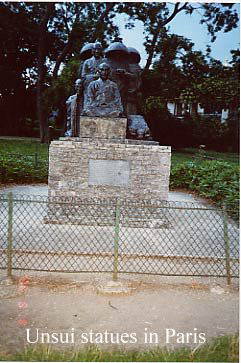
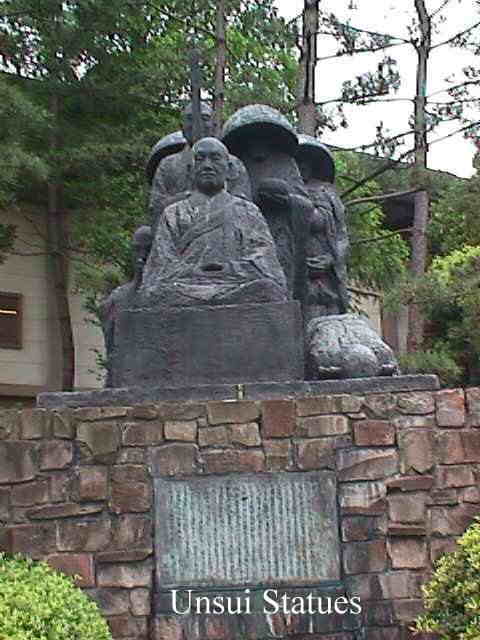 Unsui
is a word combined un (cloud) with sui (water) and Unsui
means a mendicant Zen priest, travelling across the country in search of Buddha
teachings or great Zen masters. They go anywhere just like drifting clouds and
flowing water. Here in the Temple's grounds are the bronze statues of typical
Unsui garbed in unique clothing and bamboo hats. The statues were carved
in 1973 by Torao Yazaki (1904-1988), a famous sculptor in Japan, who studied
sculpture in France under Ossip Zadkine (1890-1967). A replica of the statues
also stands at Bois de Vincennes in Paris, which was donated by the Temple as
a token to show friendship between Japan and France. A friend of mine kindly
took the photo (right) at Vincennes when he visited Paris in August 2000 to
see his daughter who was living there. Meanwhile, cultural exchanges between
Japan and France has been quite active. In 1997, for example, Japan's national
art treasure Kudara Kan'non statue, a two-meter tall Bodhisattva carved in the
7th century and enshrined in Horyuji in Nara, left Japan for the first time
ever for France to be on view for French people in its Japan Year. In return,
the French government made "Liberty Leading the People" painted in 1830 by Eugene
Delacroix (1798-1863) available for the France Year Exhibition in Japan. President
Jacques Chirac has visited Japan nearly 45 times.
Unsui
is a word combined un (cloud) with sui (water) and Unsui
means a mendicant Zen priest, travelling across the country in search of Buddha
teachings or great Zen masters. They go anywhere just like drifting clouds and
flowing water. Here in the Temple's grounds are the bronze statues of typical
Unsui garbed in unique clothing and bamboo hats. The statues were carved
in 1973 by Torao Yazaki (1904-1988), a famous sculptor in Japan, who studied
sculpture in France under Ossip Zadkine (1890-1967). A replica of the statues
also stands at Bois de Vincennes in Paris, which was donated by the Temple as
a token to show friendship between Japan and France. A friend of mine kindly
took the photo (right) at Vincennes when he visited Paris in August 2000 to
see his daughter who was living there. Meanwhile, cultural exchanges between
Japan and France has been quite active. In 1997, for example, Japan's national
art treasure Kudara Kan'non statue, a two-meter tall Bodhisattva carved in the
7th century and enshrined in Horyuji in Nara, left Japan for the first time
ever for France to be on view for French people in its Japan Year. In return,
the French government made "Liberty Leading the People" painted in 1830 by Eugene
Delacroix (1798-1863) available for the France Year Exhibition in Japan. President
Jacques Chirac has visited Japan nearly 45 times.
Homotsukan or Treasure
House
Built
in 1974 to the memory of the Priest Keizan on his 650th onki, it houses
more than 10,000 pieces of the Temple's treasures including five ICAs.
One of the most well-known treasures would be the portrait of Lady Hoshun-in,
widow of Toshiie Maeda (1538-1599). The Maeda was a powerful feudal lord in
the Edo Period and controlled the area of today's Ishikawa Prefecture as the
richest fief in Japan. Kanazawa city was his stronghold, and even today the
city is replete with many structures constructed by the Maedas. The Temple was
closely associated with the Maedas. The multi-colored portrait is painted on
silk. As the Buddhist nun name Hoshun-in indicates, she wears a typical nun's
robe. Those days, ladies entered nunhood immediately after they were bereaved
of husbands, whose nun names always had the suffix in. Incidentally,
state-owned TV network NHK will feature the Saga of Maeda in 2001 in its 45-minute
Sunday night drama.
In the center wall of the hall, a large tapestry-like embroidered fabric is
hanging, which is called Happi and covers the chair high priests sit
on. It measures 715 by 666 centimeters made in the Edo Period. The picture shows
a roaring lion and expresses that Sakyamuni's sermon is as awe-inspiring as
lion's roar. It is an ICA.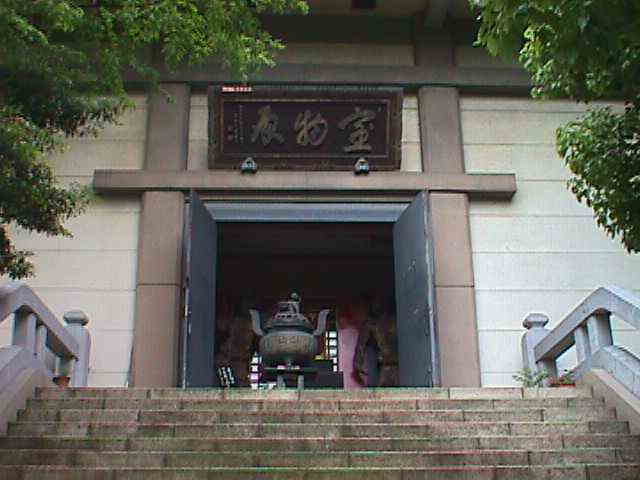
More than a dozen unique Buddha and Buddha-related statues are on regular display.
Among them are:
The House
is open from 10:00 to 16:30 (closed on Monday). Admission: 300 yen. When I visited
here on a Sunday morning in June 2000, there was no other visitors. After viewing,
I asked a receptionist if they had a list of treasures on display. She said
the House did not have one adding that the Temple is not for sightseers.
Monument
for Dr. George Trunbull Ladd
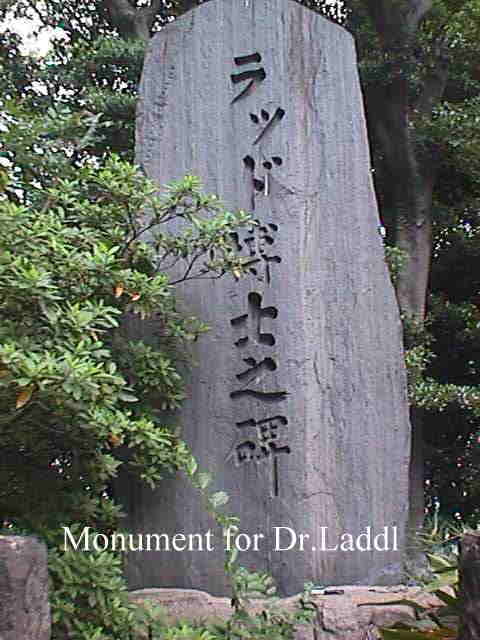 Dr.
Ladd (1842-1921) is an American diplomat, a psychologist, a clergyman and an
educator. Born in Painesville, Ohio, he became professor of philosophy at Yale
University in 1881. He is the author of Elements of Physiological Psychology,
Principles of Church Polity, Philosophy of Mind, The Doctrine of Sacred Scripture,
etc. During 1982 to 1899, he visited Japan three times at the invitation of
the Japanese Government as a diplomatic adviser and helped the Cabinet under
Prime Minister Hirofumi Ito (1841-1909) to promote mutual understanding between
Japan and America. The Government later conferred a decoration on him, the Second
Class Order of the Rising Sun. (Japanese decoration system is an imitation of
British one but there is no episode like the Garter. The "Blue Ribbon" annual
prize given to the best Japanese motion picture was named after the fact that
the certificate of the first award (1950) had a blue ribbon on it, and has nothing
to do with the Garter.) Following his will, according to a literature, parts
of his ashes are buried in the Temple. At the time I visited the Temple to see
the tomb, I thought it was located somewhere in the back graveyard. Near the
Daisodo Hall was a grave-keepers' house, in which an old lady was cleaning
the floor. Since there are so many graves in the yard, I asked her if she knew
where Dr. Ladd's tomb is. She seemed to know somehow the name of Dr. Ladd, but
not certain exactly where it is. Pulling out a brochure or two from the desk
drawers and putting eyeglasses on, she thumbed through them. After a couple
of minutes, she finally found it and told me politely where it is with a map.
I bought a bundle of incense stick paying 100 yen as other visitors did, and
proceeded toward the gate area as directed. It was not in the graveyard but
near the Temple's bell. Contrary to my expectations, it looked like a huge monument
honoring Dr. Ladd's contributions to the Japanese diplomacy. Though not sure
if it was proper to offer incense, I placed the burning incense at the foot
of the monument and bowed in Buddhist manner.
Dr.
Ladd (1842-1921) is an American diplomat, a psychologist, a clergyman and an
educator. Born in Painesville, Ohio, he became professor of philosophy at Yale
University in 1881. He is the author of Elements of Physiological Psychology,
Principles of Church Polity, Philosophy of Mind, The Doctrine of Sacred Scripture,
etc. During 1982 to 1899, he visited Japan three times at the invitation of
the Japanese Government as a diplomatic adviser and helped the Cabinet under
Prime Minister Hirofumi Ito (1841-1909) to promote mutual understanding between
Japan and America. The Government later conferred a decoration on him, the Second
Class Order of the Rising Sun. (Japanese decoration system is an imitation of
British one but there is no episode like the Garter. The "Blue Ribbon" annual
prize given to the best Japanese motion picture was named after the fact that
the certificate of the first award (1950) had a blue ribbon on it, and has nothing
to do with the Garter.) Following his will, according to a literature, parts
of his ashes are buried in the Temple. At the time I visited the Temple to see
the tomb, I thought it was located somewhere in the back graveyard. Near the
Daisodo Hall was a grave-keepers' house, in which an old lady was cleaning
the floor. Since there are so many graves in the yard, I asked her if she knew
where Dr. Ladd's tomb is. She seemed to know somehow the name of Dr. Ladd, but
not certain exactly where it is. Pulling out a brochure or two from the desk
drawers and putting eyeglasses on, she thumbed through them. After a couple
of minutes, she finally found it and told me politely where it is with a map.
I bought a bundle of incense stick paying 100 yen as other visitors did, and
proceeded toward the gate area as directed. It was not in the graveyard but
near the Temple's bell. Contrary to my expectations, it looked like a huge monument
honoring Dr. Ladd's contributions to the Japanese diplomacy. Though not sure
if it was proper to offer incense, I placed the burning incense at the foot
of the monument and bowed in Buddhist manner.
Namamugi Incident
About
one kilometer down the Temple along the Route 1 stands a stone monument in remembrance
of the historic Namamugi Incident. Namamugi is the name of this neighborhood,
where three Britons were killed or seriously injured by Japanese samurai
on August 21, 1862. They were a group of four to be exact including one woman
Mrs. Borradaile of Hong Kong and on their way from Yokohama to Heikenji in Kawasaki
on horseback. At the place where the monument stands today, they encountered
a procession of the powerful Daimyo (feudal lord) in Kagoshima Prefecture
going back home. The procession is a long one, some 400 strong parade, with
the feudal lord in a palanquin in the center. As a custom of the days, it was
imperative for the commoners to prostrate themselves on both sides of the road
and samurai on horseback had to dismount to pay respect. If there ever
were anyone who did not follow this custom, he was subject to death by slaying
on the spot. The Britons being almost totally strangers in Japan may have thought
Japan was no different from China and kept going on horseback. Enraged at the
rudeness, a lead-off samurai of the procession cautioned the group to
dismount. Unfortunately, they did not understand Japanese at all and continued
to go on. Seeing they were approaching the lord's palanquin, a few samurai
blocked them. The group noticed at last something unusual was going to happen
and tried to turn the horses back toward Yokohama, but the horses thrusted into
the procession since the road was too narrow, only two or three meters wide.
Some of samurai drew their swords and assaulted three men. (A Diplomat
in Japan written by Sir Ernest M. Satow (1843-1912) , a British diplomat
of the days, reads "They were now ordered to turn back, and as they were wheeling
their horses in obedience, were suddenly set upon by several armed men belonging
to the train, who hacked at them with the sharp-edged heavy swords.") They fled
toward Hongakuji, which was and still is located near today's Yokohama Station,
roughly 3 kilometers southwest of the incident spot, and America had a consulate
in the temple. One of them, Charles L. Richardson by name, a merchant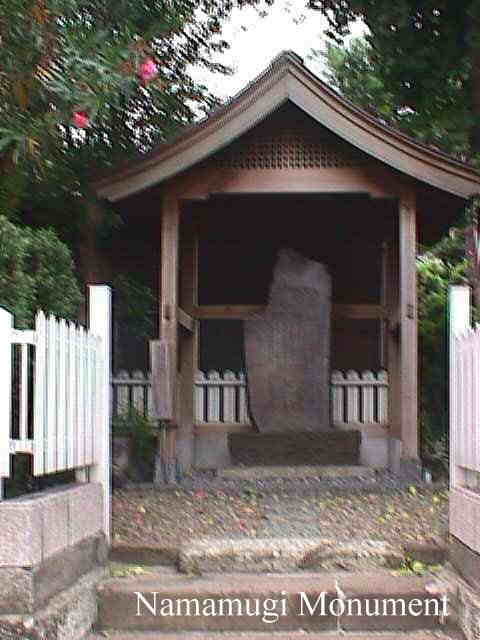 from Shanghai, fell off the horse while
on the run. A pursuing samurai caught up to him and finished by a stab
in the neck. (By chance, the samurai was elder brother of the samurai
who had assassinated Naosuke Ii (1815-1860), a high-ranking government official,
two years earlier.) Two injured Britons managed to escape and sought refuge
in Hongakuji. Mrs. Borradaile, who was unhurt, rushed to the English legation
in Yokohama for help. A 25-year-old British surgeon named William Wills, an
Edinburgh University graduate, who had been sent to the British legation in
Yokohama a year earlier, was dispatched to the scene. Confirming Richardson's
death, he went to Hongakuji and took care of the two wounded Britons who were
almost killed. Immediately after the incident, the British government demanded
the Tokugawa Shogunate to pay an indemnity of 100,000 pounds sterling, and Kagoshima
Daimyo to pay 25,000 pounds and to execute the killer samurai. The Shogunate
reluctantly accepted the request, whereas the Daimyo had no intention
to pay, much less to execute the samurai. As a result, the Kagoshima-British
Battle broke out. In July 1863, British fleet of seven warships entered Kinko
Bay in Kagoshima and began to exchange cannon fires, with British 101 cannons
as against Kagoshima's 83. The British fleet lost a total of 13 soldiers including
the flagship's captain, but Kagoshima sustained far greater damage. Nearly 10
percent of the town were burnt to the ground. Kagoshima Daimyo recognized
anew that their military power was no match for Western technology, and changed
its xenophobia policy. Not only did they accept British demand, they sued for
peace, and a close relationship between the two was rapidly cultivated. After
the Meiji Imperial Restoration of 1868, in which Kagoshima played a pivotal
role, the major Cabinet members were shared by those from Kagoshima domain.
They vigorously employed British systems. Just to mention a few, Japanese cars
run on the left-hand side of road as if Japan had been a member country of the
Commonwealth. The size of all Japanese newspapers measures 32 by 21.5 inches
per sheet (four pages) because in the early Meiji Period (1868-1912), Japan
imported newsprint from Britain where the 32-inch width was the standard size.
In particular, Surgeon Wills rendered great services for the wounded in the
Japanese civil war before the Restoration and contributed to the development
of Japanese medical technology. It's been nearly one and a half centuries since
the Incident, and today, few people know what the monument is for.
from Shanghai, fell off the horse while
on the run. A pursuing samurai caught up to him and finished by a stab
in the neck. (By chance, the samurai was elder brother of the samurai
who had assassinated Naosuke Ii (1815-1860), a high-ranking government official,
two years earlier.) Two injured Britons managed to escape and sought refuge
in Hongakuji. Mrs. Borradaile, who was unhurt, rushed to the English legation
in Yokohama for help. A 25-year-old British surgeon named William Wills, an
Edinburgh University graduate, who had been sent to the British legation in
Yokohama a year earlier, was dispatched to the scene. Confirming Richardson's
death, he went to Hongakuji and took care of the two wounded Britons who were
almost killed. Immediately after the incident, the British government demanded
the Tokugawa Shogunate to pay an indemnity of 100,000 pounds sterling, and Kagoshima
Daimyo to pay 25,000 pounds and to execute the killer samurai. The Shogunate
reluctantly accepted the request, whereas the Daimyo had no intention
to pay, much less to execute the samurai. As a result, the Kagoshima-British
Battle broke out. In July 1863, British fleet of seven warships entered Kinko
Bay in Kagoshima and began to exchange cannon fires, with British 101 cannons
as against Kagoshima's 83. The British fleet lost a total of 13 soldiers including
the flagship's captain, but Kagoshima sustained far greater damage. Nearly 10
percent of the town were burnt to the ground. Kagoshima Daimyo recognized
anew that their military power was no match for Western technology, and changed
its xenophobia policy. Not only did they accept British demand, they sued for
peace, and a close relationship between the two was rapidly cultivated. After
the Meiji Imperial Restoration of 1868, in which Kagoshima played a pivotal
role, the major Cabinet members were shared by those from Kagoshima domain.
They vigorously employed British systems. Just to mention a few, Japanese cars
run on the left-hand side of road as if Japan had been a member country of the
Commonwealth. The size of all Japanese newspapers measures 32 by 21.5 inches
per sheet (four pages) because in the early Meiji Period (1868-1912), Japan
imported newsprint from Britain where the 32-inch width was the standard size.
In particular, Surgeon Wills rendered great services for the wounded in the
Japanese civil war before the Restoration and contributed to the development
of Japanese medical technology. It's been nearly one and a half centuries since
the Incident, and today, few people know what the monument is for.
Tomb of Yujiro Ishihara
At the
gate of the temple's cemetery is a signpost showing the direction toward the
tomb of Yujiro Ishihara (1934-1987), one of the most popular movie actor. He
is the younger brother of Tokyo Governor Shintaro Ishihara (1932-). Shintaro
Ishihara won Japan's most prestigious literary (Akutagawa) prize, a gateway
to prominence for new writers, with his novel A Season of the Sun in
1956 at age 23 while he was an undergraduate student of Hitotsubashi University,
one of the oldest and most prominent institutes for social science in Japan.
The novel depicted sexual challenges among youth, which were still tabooed in
Japan and the book was listed on top of the best-sellers creating the term "Sun
Tribes". In filming the novel, he nominated his brother Yujiro as the hero,
whereby Yujiro rose to the outright super-star. Unfortunately, he died of liver
cancer in 1987 at age 52 and was buried here. At the memorial service for his
12th anniversary of death, which took place in July 1999, nearly 200,000 mourning
fans reportedly joined the ceremony jeopardizing traffic flows near the Temple
all day long. Later, the neighbors accused the Temple and the mass organizer
as well as the police of not taking necessary measures. Even today, many fans
seem to visit the tombs as the signposts are seen in the graveyard.
Shintaro is well known overseas with his another book The Japan That Can
Say No (1989). Since he took Governor's office in April 1999, his controversial
comments and actions have infuriated central government bureaucrats. The Time
magazine (Asian Edition) reported that "he seems to get into trouble every time
he opens his mouth. But, Japan's most controversial politician is one of its
most popular." For example, he invited the Dalai Lama to visit his office, accused
China of its human right policy, visited Taiwan in May 2000 to attend the Inauguration
of President Chen Shui-bian, imposed a 3 percent levy on the revenue of large
banks, paid an official visit to Yasukuni Shrine on August 15, 2000 for the
first time ever as the Tokyo governor to attend an annual memorial service held
for the war-dead including class-A war criminals----, all are what the bureaucrats
and parliament members cannot or hesitate to act. Among many comments he made
is "Credit rating agencies like Moody's and Standard & Poor's are the backup
fighter planes for the American economy". As of summer 2000, opinion polls showed
the support rate for his governorship reached over 70 percent, as against 21
percent for the Prime Minister Mori and his cabinet.
Notes
Zazen
practice
The Temple offers foreigners to join zazen session. There are the following
two classes with English speaking instructors:
Sunday session starting 12 noon and ending 5:00 p.m. Membership fee is 1,000
yen and 200 yen per session,
Overnight stay session: Once a month on Saturday from 6:00 p.m. ending 9:00
a.m. the next morning,
For further details, call 045-581-6021.
According to the Temple's chronicle, it once opened a Zazen school in the Sony
Building located in Ginza, Tokyo in September 1973. Recently, I stopped by the
building to check if the school is still open. A young receptionist said that
she has "never heard anything like that." Seems to be closed long ago.
When young men who join the Temple to become the priests and start ascetic training,
almost all of them will suffer a vitamin deficiency syndrome within several
days. Poor food with less than 1,000 kilo calories per day are always vegetarian
with no animal protein. Nevertheless, all chief priests of the Tempe are known
for their longevity, living to be over ninety. Diabetes, hypertension, high
cholesterol, heart conditions are the last things they suffer. A characteristic
common to all of them is that they are thin and far from obese. Nutritionists
should clarify why those people with apparent malnutrition can live so long.
(A Japanese medical doctor who is an authority on Werner Syndrome says that
human genes allow us to live over 100 years. If you want to live long, he says,
you have to: (1) Cut your calory intake by half, whereby oxidant can be reduced,
(2) Walk at least 10,000 steps a day. Not only does walking make your body strong
physically, but also activate your brain, (3) Drink two litres water a day to
promote metabolism, (4) Be sociable, and (5) Think positively, try to live long.
The Asahi Shinbun, the largest daily in Japan, reported
in a March 2001 issue.)
Priest Ryokan (1758-1831)
Probably,
he is one of the most popular priests to the Japanese and even children may
have heard of his name. Born in Niigata Prefecture, he entered priesthood at
a nearby Soto Zen temple at age 18. Despite the fact that he was indirectly
involved in publishing the Shobo Genzo and familiar with it, what he
preached was easy to understand for the laity. And yet he remained a typical
mendicant priest, or a friar in Christian term, for the entire life travelling
across the country without staying or having any temples. In later years, he
came back to home town and lived in genteel poverty. He also loved children
and played with them. He was also good at Chinese poets as well as Japanese
tanka, or 31-syllable-verse. Among many famous phrases he made is : "When
you are to meet with natural disasters, you should meet them. When your death
is unavoidable, you should accept it."
Soto Sect's affiliated institutes
Adjacent
to the Temple is Tsurumi University which is run by the Temple and has the faculties
of Literature and Dentistry.
The Soto Sect has a number of affiliated organizations, mostly educational institutes,
as listed below:
Komazawa University and Komazawa Women's College in Tokyo; Aichi Gakuin University
in Aichi Prefecture; Aichi Junior and Senior High Schools in Nagoya; Tohoku
Fukushi University in Sendai, Miyagi Prefecture; Setagaya Gakuen Junior and
Senior High Schools in Tokyo; Tatara Gakuen High School in Yamaguchi Prefecture;
Toyokawa High School in Aichi Prefecture, etc.
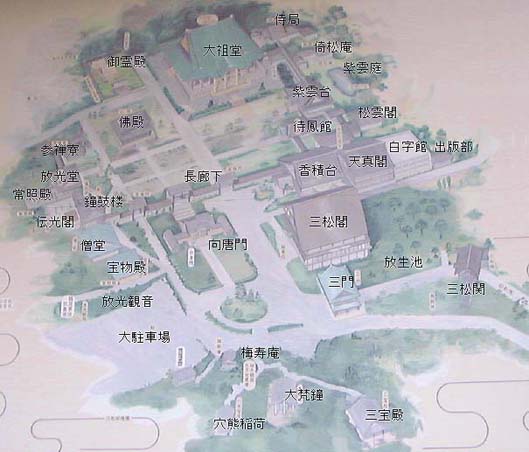
| Daihonzan Sôji-ji (Kanagawa) | ||
| Address | 1-1 Tsurumi 2-chome, Tsurumi-ku,Yokohama-shi, Kanagawa-ken 230-0063 | |
| TEL | 045-581-6021 to Rev. Azuma Roshi |
|
| Transportation | A 5 minute-walk from Tsurumi sta. on JR Keihin-Tohoku Line or KeihinTsurumi sta. Keihinkyuko Line | |
| 1)Sundays ZAZENKAI | From 12:00 p.m. to 5:00 p.m | |
| Acceptance fee | 1,000 yen- | |
| Participation fee | 200 yen- | |
| Language | English | |
| Lecture | Shobogenzo | |
| Others | Discussin | |
| 2) Monthly Over Night ZAZENKAI | Arrival: 6:00 p.m. (Saturday) Depature: 9:00 a.m.(Sunday) | |
| Participation fee | 1,500 yen | |
| Language | English | |
| Lecture | ||
| 3) Private Over Night ZAZENKAI (Monthly) | Arrival: 9:00 a.m. (Saturday) Departure: 4:00 p.m.(Sunday) | |
| Participation fee | 5,100 yen- | |
| Language | English | |
| Lecture | Gakudoyojinshu | |
| Others | Discussin Shakyo (Copying of Sutra) /Disscusion | |
| 4) SESSHIN | 1.
Denko-e Sesshin: June 16th - 20th 2. Summer Sanzenkai: July 21st - 25th 3. Rohatsu Sesshin-e: December 1st - 8th |
|
| Participation fee | 15,000 yen- | |
| Others | Applications must be made by one month before you arrival and should contain the following information: name, address, phone number, age, sex, occupation,condition of health. | |
SZÓDZSI-DZSI
A HATVANAS ÉVEKBEN
Sôjiji
in the Sixties